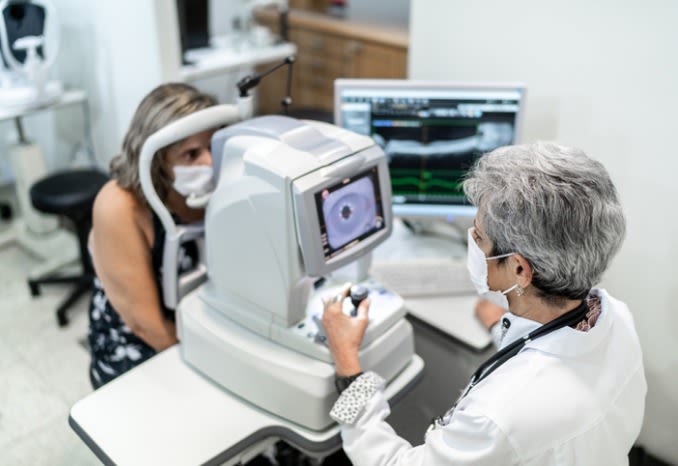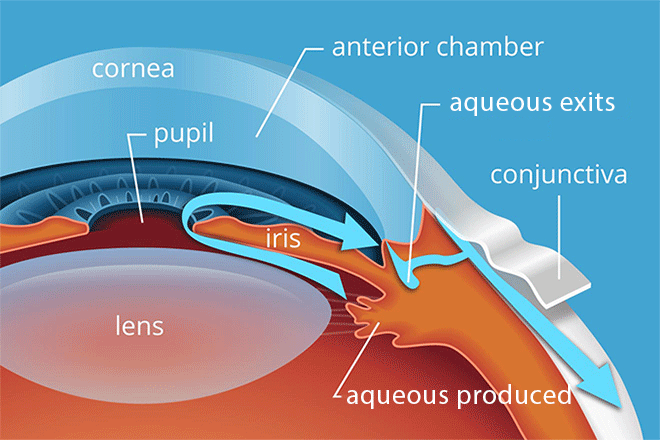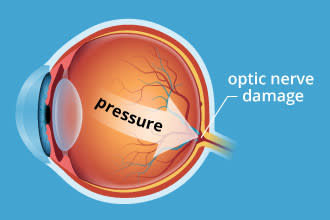What causes glaucoma?

Generally, the cause of glaucoma is a failure of the eye to maintain an appropriate balance between the amount of fluid produced inside the eye and the amount that drains out of the eye.
Underlying reasons for this imbalance usually relate to the type of glaucoma you have.
Just as a tire requires air pressure to maintain its shape, the eyeball needs internal fluid pressure to retain its globe-like shape and ability to see.
But when something affects the ability of internal eye structures to regulate intraocular pressure (IOP), eye pressure can rise to dangerously high levels, causing glaucoma.
Unlike a ball or balloon, the eye can't relieve pressure by developing a leak or "deflating" when pressure is too high. Instead, high eye pressure just keeps building and pushing against the optic nerve until nerve fibres are permanently damaged and vision is lost.
Glaucoma and eye anatomy
When glaucoma progresses, nerve damage ultimately leads to peripheral vision loss. Left untreated, glaucoma can eventually cause blindness.
To understand what causes glaucoma, you first must know something about the anatomy of the eye and how intraocular fluid moves through it:
The clear fluid inside the eye is produced by the ciliary body, which is a small, circular structure found behind the iris (the coloured portion of the eye).
This fluid, known as the aqueous humor, flows behind the iris and through the pupil (the central opening in the middle of the iris). The aqueous humor (or just "aqueous") then fills the anterior chamber, a space between the back of the clear cornea and the front of the iris.
The aqueous exits the eye through a structure known as the drainage angle, which is the angle formed between the iris and the peripheral cornea inside the anterior portion of the eye.
The aqueous filters through this angle and through the sclera (the white part of the eye) and then joins with the network of veins outside the eye.
Any disruption of this outflow of aqueous — including from certain eye injuries — can result in an increase in IOP.
Anatomically, the eye's drainage angle is referred to as being either "open" or "closed" (narrow). The narrower the angle, the more difficult it is for the aqueous to flow through it.
An open angle can also hinder the outflow of aqueous if structural damage exists within the ocular tissues of the angle itself.
Read more about open-angle glaucoma and narrow-angle glaucoma.
Other glaucoma causes: Poor blood flow, optic nerve damage
While high IOP is often associated with glaucoma, this eye disease also can occur when internal eye pressure is normal (normal-tension glaucoma). People with this condition have highly pressure-sensitive optic nerves that are susceptible to irreversible damage from what would ordinarily be considered "normal" IOP.
Conversely, certain people with elevated intraocular pressure, known as ocular hypertension, may never develop glaucoma.
Most conventional methods of screening for glaucoma involve testing eyes for the presence of high IOP. But because glaucoma can occur even without high IOP, direct examination of the optic nerve and visual field testing are essential in making (or ruling out) the diagnosis of glaucoma.
Though the exact cause of normal-tension glaucoma is unknown, many researchers believe decreased blood flow to the optic nerve may be a factor. This could be caused by narrowing or constrictions of blood vessels that nourish the optic nerve.
Some studies also indicate that poor blood flow within the eye is associated with blind spots that develop within the visual field, similar to those that occur in glaucoma.
Glaucoma and Alzheimer's disease: A common cause?
Visual impairment is common among people with Alzheimer's disease (the most common form of dementia), and some research has shown glaucoma and Alzheimer's disease have similarities — including the production of free radicals and protein deposits in the retina — that may suggest the two diseases have a shared or similar cause.
Though the connection between glaucoma and Alzheimer's disease is still unclear and needs further investigation, some eye care professionals feel this discovery might help researchers find answers to important questions and advance progress toward a cure for both diseases.
Schedule routine eye exams
Whatever the underlying cause of glaucoma is, early detection of the disease is essential to prevent vision loss. This is probably the most important reason for you to schedule an annual comprehensive exam with an eye care professional — especially after age 50, when glaucoma occurs more frequently.
FIND AN OPTICIAN: An optician can assess your vision, find an optician near you.
Page published on Wednesday, 16 March 2022








